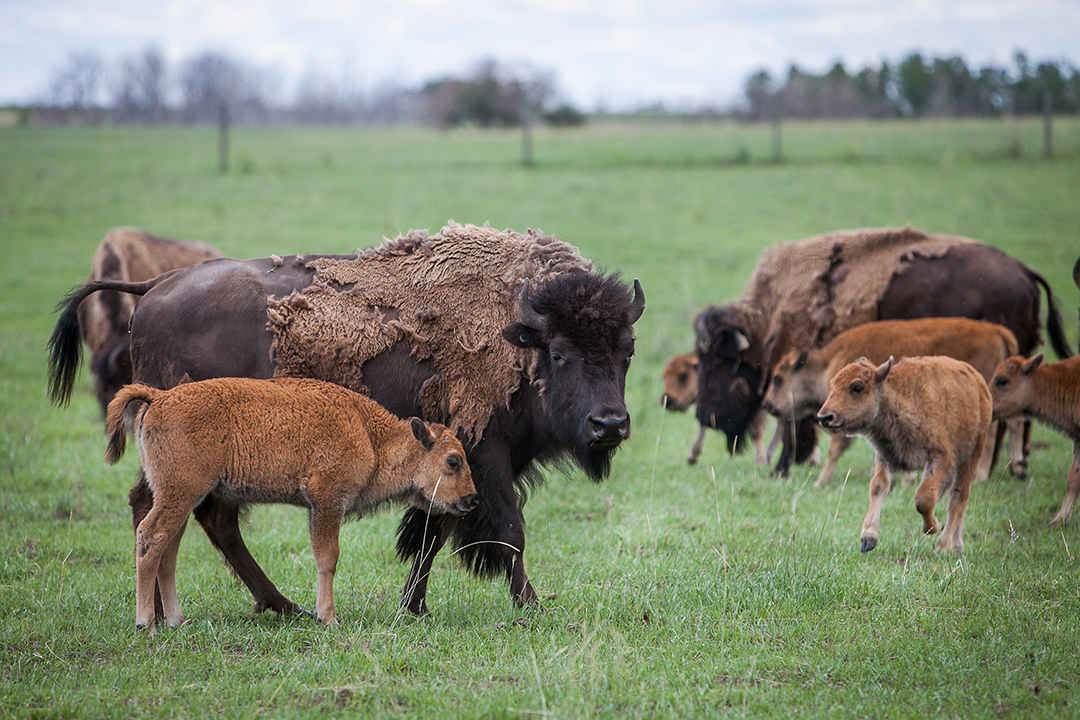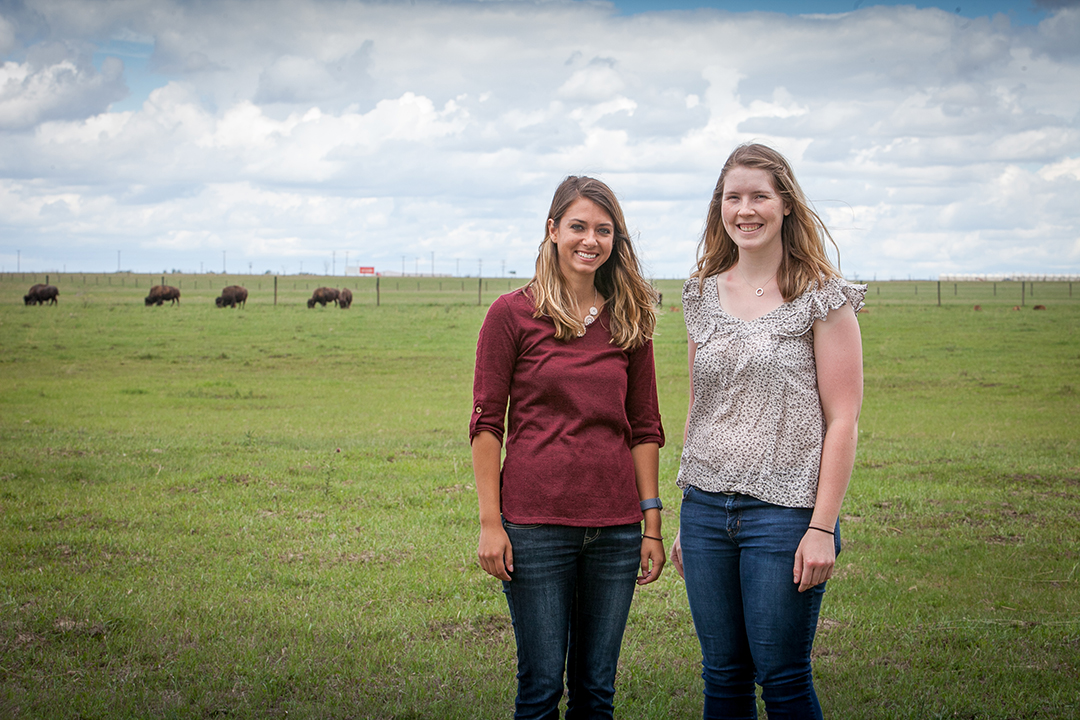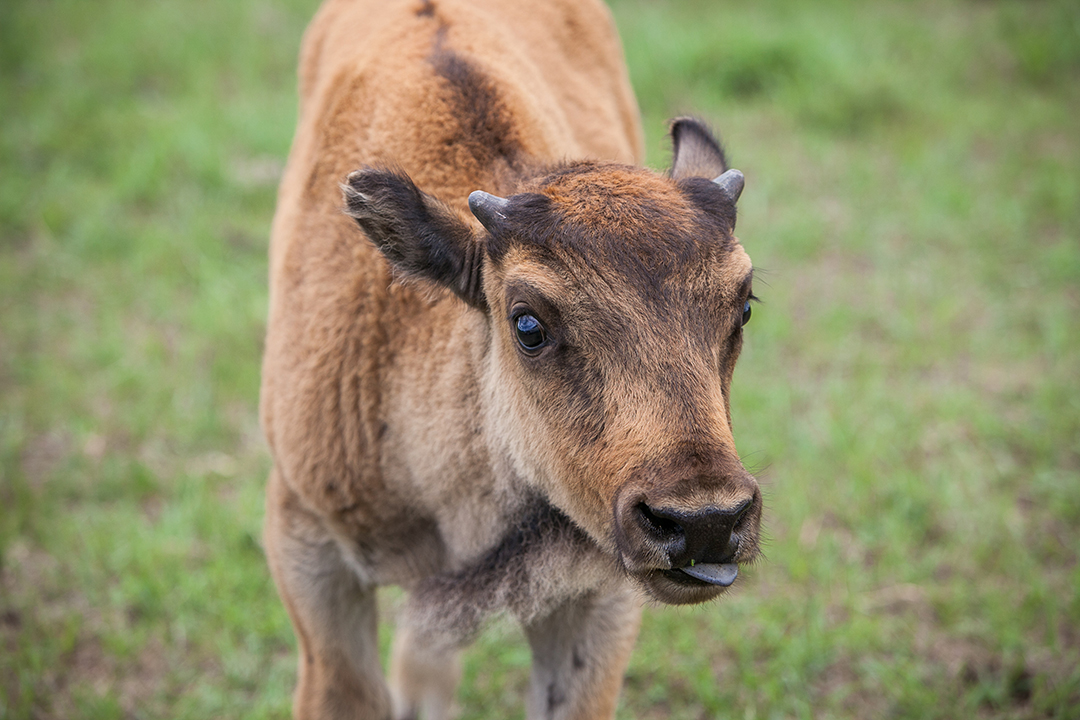
‘Why wait?’ researchers work toward bison biobank
The day begins beautifully. The sun is shining and the vivid blue sky stretches out over the never-ending prairies. I’m at the Specialized Livestock Research Centre — part of the University of Saskatchewan’s Livestock and Forage Centre of Excellence (Goodale Farm). Believe it or not, I’m helping to shift a sedated, 550-kilogram bison cow into a better position to collect her eggs (oocytes).
By Victoria WallaceShe’s magnificent, albeit somewhat shaggy from the remaining winter coat still attached to her large hump, underbelly and the back of her hindlegs. The light brown hairs atop the bison cow’s hump darken to chocolate brown before becoming black above her cloven hoofs. A thick forelock of dark hair sits just above her eyes and covers the top of her massive head and floppy ears, now hidden by a neon yellow cover.
The bison cow snorts with every exhale and her breaths are heavy. With the bison cow properly positioned and the equipment set, we’re to begin the collection.
I’m part of a research team at the Western College of Veterinary Medicine (WCVM) that’s investigating reproductive technologies in bison to aid in their long-term survival. One of my supervisors, Dr. Gregg Adams, is renowned for his research in reproductive technology.
Adams is also one of the researchers involved in the international Bison Research Group that includes representatives from federal, provincial and territorial governments, Canadian universities and zoological parks, commercial bison producers and the World Wildlife Fund.
Since its inception in 2006, the group has established a herd of wood bison derived from Elk Island National Park (EINP). The group and its research partners have also “celebrated several ‘firsts’ since then, including the world’s first bison offspring from frozen embryos and semen,” says Adams.

Adams and his graduate student, Miranda Zwiefelhofer, are working to modify the established protocols for collecting bison eggs to work in field conditions. This involves determining the feasibility of collecting eggs and producing in vitro embryos from sedated bison in the field with the same success they have achieved with bison restrained in a hydraulic chute.
The study will bring them one step closer to their goal: setting up a biobank for bison germplasm (living genetic resources). The process is complicated, but Zwiefelhofer says it would help to ensure the success of the species.
“A germplasm biobank preserves gametes (eggs, semen and embryos) in liquid nitrogen to be used at a later date,” says Zwiefelhofer. “This allows genetics to move, either to a new animal on site or anywhere else in the world, in a biosecure way.”
Producing a biobank is important to protect bison against the threats they face, both from the natural world and from people.
About 30 million bison once freely roamed North America, but during the 1800s, a culmination of factors decimated bison populations. Among those factors was the influx of people, which led to the over-exploitation of bison through trade and sport hunting. Settlers also brought with them domestic livestock that competed for resources and introduced new diseases to the bison.
Many benevolent efforts were made in the last century to conserve the remaining bison populations, but unforeseen complications have made things more difficult.
Adams says North American bison populations are threatened by several factors. Existing herds are small in number and spread out geographically. Experimental breeding done nearly a century ago has caused cattle gene introgression (introduction of genes from one species into the gene pool of another species). As well, breeding between plains and wood bison have created sub-species hybrid animals.
Diseases — endemic and epidemic — have affected bison as well as farm animals and people. Another influence is intentional and unintentional selection of breeding animals.
“These factors place existing herds of wood and plains bison in danger of potential catastrophic consequences of chance events [such as] severe winters, floods, and disease outbreaks.” explains Adams.
With an uptick in the number of cattle ranchers choosing to switch to bison production, the population of bison raised on-farm appears to be stable. But few wild bison herds are free of disease and hybridization, and as a result, there are not enough bison to sustain the populations.
Although current populations aren’t in imminent danger, Adams says being proactive is important.
“Why wait? The longer we wait, the more difficult the fix and the greater the risks,” says Adams. “While easily and quickly lost, restoration of genetic diversity is an evolutionary process that requires many generations.”

The success of transitioning the protocols to field conditions will not only bring these researchers closer to establishing the world’s first bison genome biobank, but it will also allow them to collect eggs from free-roaming bison. The team is hoping to eventually visit bison herds in Alaska where they can work in a true field setting.
The implications of this project are not limited to help sustain the bison populations for the long term. Both Adams and Zwiefelhofer agree that this solution could benefit many other species that may share the same plight as the bison.
But for now, the focus remains on the iconic species.
“Human intervention caused the downfall of the bison … we owe it to the bison [to fix this,]” says Zwiefelhofer.
This project has financial support from the Natural Sciences and Engineering Research Council of Canada (NSERC) and the Saskatchewan Agriculture Development Fund.
Victoria Wallace of Chilliwack, B.C., was one of the WCVM’s Boehringer Ingelheim Veterinary Scholars during the spring and summer of 2019. The second-year veterinary student’s story is part of a series of articles written by WCVM summer research students.

